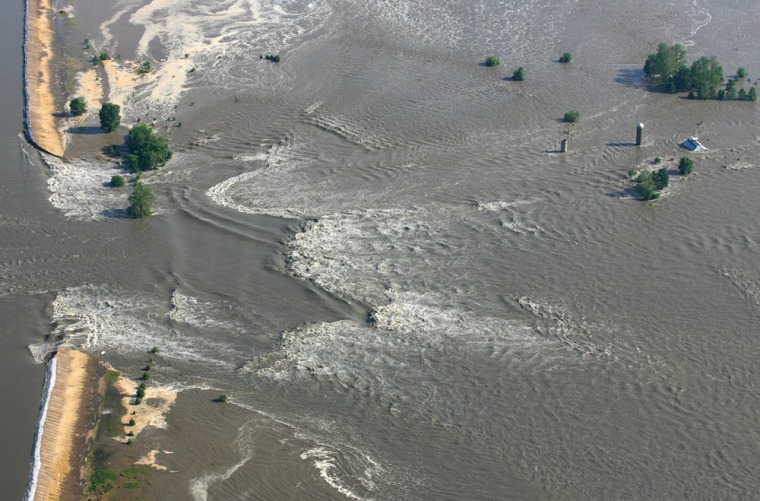With the spring flood season fast approaching, the Army Corps of Engineers insists the earthen levees that were overwhelmed by the Mississippi River last summer are rebuilt and ready. Some people who depend on the levees aren't so sure.
It was nearly nine months ago that the river neared and, in some cases, exceeded the record levels that were reached in the Great Flood of 1993, something many Midwesterners figured they'd never see again. The Mississippi and its tributaries pummeled levees protecting towns and farmland from Iowa south through St. Louis, breaching or overflowing dozens of the earthen structures.
Corps officials say holes in the levees have been fixed. The Corps has spent some $64 million so far to fix breaches in about 70 levees in Iowa, Illinois and Missouri.
"It should give them (people protected by levees) a certain level of confidence," says Alan Dooley, a spokesman for the Corps' St. Louis district.
Some say the Corps is too slow
That's little comfort for the local officials worried about whether the repairs go far enough, especially since early spring is the rainiest and most flood-prone time of the year. Local levee officials in the hardest hit states — Iowa, Illinois and Missouri — believe the Corps is moving too slowly to fix the infrastructure.
"We're very concerned," said Stan Rolf, president of the levee district at Winfield, Mo., where a burrowing muskrat caused a breach that eventually flooded 100 homes and damaged nearly 2,000 acres of farmland. "Every farmer is concerned about it. It's our livelihood."
At least for now, the weather outlook appears far more favorable than a year ago, when there was "the perfect setup" for big trouble, according to Bob Holmes, national flood specialist with the U.S. Geological Survey.
That winter's meltoff from huge snowstorms filled the Mississippi and its tributaries and persistent rain saturated the soil. Then a storm in June dumped more than 10 inches of rain on parts of Iowa and Wisconsin.
"We're not looking at nearly the potential of flooding this year," said Mark Fuchs, a National Weather Service hydrologist. "But there's always the disclaimer: If we have a big (rainfall) event we could always see significant flooding."
Water submerged acres of farmland
One of the local officials still worried about that possibility is Marty Lafary, the board chairman of Henderson County in northwest Illinois. The Mississippi broke one of the levees in the county last June, swamping the tiny village of Gulfport. Water submerged tens of thousands of acres of farmland and one-third of the county's tax base.
Lafary argues that the earthen wall ruptured because it was unstable, but Corps officials say the river was to blame, that water simply rose over its top and eroded it.
Worried about the stability of wall
Although the Corps has repaired the gap, Lafary is still leery about the basic stability of the wall, built decades ago atop an old railroad bed. He said he's afraid high water could shift old railroad ties buried inside the levee, catastrophically weakening the wall.
But Dooley, the Corps spokesman, said the agency is authorized to repair compromised levees only to their previous levels of protection. He said it needs congressional approval and funding to rebuild levees bigger and wider.
"We have to work within this system," Dooley said.
About 45 miles south of Gulfport, in Adams County, Ill., the Mississippi overwhelmed two levees, submerging tens of thousands of acres of farmland and devastating Meyer, a hamlet of a few dozen people.
'I think that's a huge mistake'
Repairs are expected to be completed this month on one of those levees, in the Indian Grave Drainage District north of Quincy.
"It's not going to be better than it was before the last two floods we had" in 1993 and last year, "and I think that's a huge mistake," said David Shaffer, the levee district's commissioner. "If the government would just get busy and get a project going to where they build everybody's levees up to withstand these high-water events, everybody would be better off."
In Iowa, much work remains on a vital levee in Des Moines even though a gaping hole has been fixed that released the Des Moines River into more than 200 homes, three dozen businesses and a school.
The city of Des Moines recently contributed $600,000 to finish design work on a new levee, said Ron Fournier, spokesman for the Corps' Rock Island, Ill., district. Even through construction could begin this year, city councilman Bob Mahafee is frustrated with the Corps.
"We're just stalemated, waiting on them to act," he said. "It just seems like nobody is moving on it."
No matter what steps are taken, however, much of what floods and what doesn't comes down to luck, said John Simon, the emergency management chief in Adams County.
"Fighting off Mother Nature," he shrugged. "Sometimes it just can't be done."
